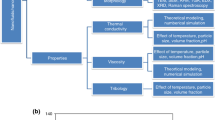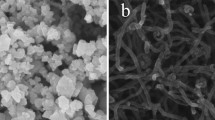Abstract
Recently, many researchers are giving lots of attention towards the potential usage of nanolubricant because of their ability to enhance the thermophysical properties of heat transfer fluid and their application in various industries. The aim of this experiment is to evaluate the stability and thermophysical properties of functionalized multi-walled carbon nanotubes (F-MWCNT), graphene, silicon dioxide (SiO2), hybrid F-MWCNT/graphene and hybrid F-MWCNT/silica nanoparticle in polyester oil. The suspension is characterized by visual observation, thermal conductivity, and viscosity. The results showed that the highest enhancement of thermal conductivity at 0.1 vol% of mono nanolubricants and at ratio of 0.05:0.05 vol% for both hybrid nanolubricants. The thermal conductivity and viscosity increased with nanoparticle concentration.
Access provided by Autonomous University of Puebla. Download conference paper PDF
Similar content being viewed by others
Keywords
1 Introduction
Incorporating nanofluids into the cooling system is one of the best ways to increase the performance of Automotive Air Conditioning (AAC) system by replacing traditional lubricants with nanolubricants [1]. The addition of nanoparticles to the base fluid will ultimately boost their transport properties and efficiency of the device, irrespective of the possibilities that should be purposely evaluated for the pressure effect. With substantial advantages for compressors against wear properties and high-pressure conditions, lubricity can also boost its tribological characteristics [2]. A solution for enhancing the cooling system's efficacy may be the insertion of nanoparticles into the base fluid or working fluid, such as compressor oil [3]. In refrigeration systems, the use of nanolubricant can increase heat transfer. Still, at the same time, the pumping power is increased because the viscosity of the nanolubricant is greater than the standard oil viscosity [4]. A rise in viscosity is unavoidable when adding nanoparticles to the base fluid. The thermal conductivity coefficient or heat transfer should not be affected by the increase in nanofluid viscosity.
Nanofluid usually uses water, ethylene glycol, and oil base fluid that can be considered water or oil-based fluid. The metal group, ceramic group, and carbon group are nanoparticles that are commonly added. To make nanolubricants, nanoparticles may also be added to the base lubricant. Nanolubricant technology has evolved from time to time, together with the rapid development of technology.
The first nanolubricant generation concentrates more on only one type of nanoparticles mixed into the base lubricant. Sharif et al. [5] examined the influence of Al2O3 on the performance of PAG lubricant. The results of the thermophysical study indicate that thermal conductivity is increased to 4% at 1.0 vol%. However, the Al2O3/PAG viscosity has increased sharply to 700% at 0.4 vol%, which limits the potential of nanolubricants. This is because the high viscosity lubricant tends to gain greater pumping power despite having more better anti-friction properties [6].
Nanolubricant’s second generation is called a hybrid nanolubricant. In general, a mixture of two or more types of nanoparticles added to the base lubricant was compromised by hybrid nanolubricant. The usual hybrid nanolubricant improves stability, heat transfer, and tribology. However, depends on the ratio of nanoparticles inside the lubricant. Zawawi et al. [7] have studied Al2O3/SiO2 and PAG nanolubricant's thermophysical properties. The thermophysical properties of the nanolubricant improved up to 2.4% and 9.71% respectively with improved thermal conductivity and viscosity at 0.1 vol%. The thermal conductivity improvements are better than Al2O3/PAG and SiO2/PAG, with a small viscosity increase. A higher hybrid nanolubricant concentration can be used in AAC due to the minimal viscosity increase compared with the mono nanolubricant. The hybrid nanolubricant also has a higher value thermal conductivity, which is more stable with less sedimentation. In a further study, the Al2O3/SiO2/PAG hybrid nanolubricant has a high friction coefficient (COF) with a better anti-wear property of 5% and 12% [8]. These helps to reduce mechanical friction within the compressor to lengthen the AAC compressor’s service life.
Many researchers have extensively studied on oxide nanoparticles in nanolubricants in recent years. Little attention has been paid in evaluating the performance of carbon-based nanomaterials (F-MWCNT and graphene) in nabolubricants. In the present study, the stability, thermal conductivity, and viscosity of mono nanolurbicants (F-MWCNT, graphene, SiO2) and hybrid nanolubricant (F-MWCNT/graphene and F-MWCNT/SiO2) with polyester oil as the base fluid was carried out. To confirm the stability of nanolubricant, visual inspection was carried out for 14 days. The results are presented for volume concentration up to 0.1% and viscosity is measured at the temperature of 40 °C and 100 °C.
2 Materials and Methods
2.1 Material
Graphene nanoplatelet with 11 to 15 nm thickness and 15 micron of average particles size was purchased from Skyping Nanomaterial. The F-MWCNT with outside diameter of 20–30 nm, inner diameter of 5–10 nm, length of 10–30 μm and 95–98% purity synthesized via catalytic vapour deposition (CVD) was supplied by USAINS, Universiti Sains Malaysia, Penang. SiO2 was purchased from Sigma-Aldrich with average particle size of 12 nm. The base fluid used in the experiment is SUNISO synthetic refrigeration polyester oil with additives referred as SUNISO SL68. It has kinetic viscosity at 40 °C of 70.1 cSt and density of 0.960 g/cm3.
2.2 Nanolubricant Preparation
Graphene, silica, F-MWCNT and hybrid nanolubricant were produced by two-step method, using the polyester oil as the base fluid. Mono nanolubricant was prepared at volume concentration of 0.025% to 0.1%. While for F-MWCNT/graphene and F-MWCNT/silica hybrid, volume concentration ratio of 0.075:0.025, 0.05:0.05 and 0.025:0.075 in polyester oil.
2.3 Evaluation of Dispersion Stability
The stability of nanolubricants was evaluated using sedimentation photographs and metallographic microscopy. The nanolubricants were filled into clear vials of 30 ml after sonication to observe the nanolubricant’s stability over 14 days of visual inspection. The samples were observed daily until the nanoparticles sedimented at the base of the vial and obvious separation of nanoparticles and oil could be seen.
2.4 Thermal Conductivity
The thermal conductivity of nanolubricant is measured using KD2 Pro Thermal properties analyser (made: Decagon, USA) with the sensor KS-1-0063. The thermal conductivities of the nanolubricant of different volume concentrations were recorded as parameters of result interpretation. This instrument uses the concept of transient line heat source to determine the thermal conductivity. This measurement was done at room temperature.
2.5 Viscosity Measurement
Viscosity test was conducted to measure the viscosity of each of the different nanolubricant concentrations at temperature of 40 °C and 100 °C. It is the viscosity at the operating temperature of machine that is critical to understand. The cone and plate rheometer was used to measure the viscosity of nanolubricant. The measuring cone CP25-2 with diameter of 25mm (angle 2°) and a speed of 100 rpm was used in the measurement. The instrument was set to measure 29 points from shear rate of 0 to 100 s−1.
3 Result and Discussion
3.1 Stability of Nanolubricant
Visual inspection of F-MWCNT, graphene and SiO2 nanolubricant in polyester oil as the base fluid is shown in Fig. 1 and for hybrid nanolubricant it is shown in Fig. 2. On day 7, graphene nanolubricant with high concentration of nanoparticles have higher tendency to sediment. The graphene nanolubricant shows black deposition at the bottom of the bottle which relates to the settling of graphene and indicate that graphene is not stable beyond 2 weeks. By comparing these 3 nanolubricants, it can be seen that the settling of graphene nanoparticles is more obvious than the other. On the other hand, no obvious sedimentation was observed for F-MWCNT and SiO2 nanolubricant up to 14 days observation.
On day 14, hybrid nanolubricant show obvious sedimentation when the volume concentration ratio of graphene is more than F-MWCNT (Fig. 2(i)(e) and (f)). Since F-MWCNT and graphene nanoparticle is an insoluble compound, the nanoparticles will sediment due to gravitational pull [9]. While for hybrid F-MWCNT/SiO2 nanolubricant, no sedimentation is observed until day 14 indicating that the nanolubricants are stable.
3.2 Thermal Conductivity
Thermal conductivity of mono and hybrid nanolubricant is shown in Figs. 3 and 4, respectively. The measurements were taken at room temperature and 1 h after sonication, letting the nanolubricant to cool down to get accurate readings. The thermal conductivity was measured using KD2 Pro and the measured value of polyester oil was 0.134 W/m.K. Addition of F-MWCNT, graphene and SiO2 increase the thermal conductivity of the oil. The highest enhancement was shown at 0.1 vol% for F-MWCNT, graphene and SiO2 which was 0.139 W/m.K. A value of 3.7% improvement in thermal conductivity of nanolubricant was observed at 0.1 vol% compared to pure oil. Improvement in a range of 1.5% to 3.0% was shown for the other samples. A previous study by Ettefaghi et al. [10] reported the use of 1 wt% MWCNTs in oil SAE20 has recorded an improvement of 15% in thermal conductivity. Singh et al. [11] examined thermal conductivity of CNT/EG nanofluid. The results showed that the thermal conductivity increased with higher mass concentration of CNT. At 0.4wt% nanotube loading, 72% improvement was achieved.
MWCNT and graphene nanoparticles are known to have high thermal conductivity, low specific gravity, high aspect ratio and high heat transfer potential [12]. Sanukrishna and Prakash [13] reported that the heat is assured to flow from the oil molecules to the graphene particles at solid-liquid interface as thermal conduction. For this reason, a nanofluid with long-term stability and proprietary thermal properties can be made with a combination of FMWCNT and graphene nanoparticles. The results in Fig. 4, show the highest increase in thermal conductivity of 0.143 W/m.K for ratio of 0.05:0.05 F-MWCNT/graphene hybrid nanolubricant. An increase of 6.7% is found if compared to pure oil. For hybrid F-MWCNT/SiO2, ratio of 0.075:0.025 shows the highest thermal conductivity enhancement of 3.7%. The improvement of the other samples shown to be between 3.7% to 5.2%. The findings concluded that the best ratio of hybrid nanolubricant is 0.05:0.05 hybrid F-MWCNT/graphene with the highest improvement in thermal conductivity.
3.3 Viscosity
The viscosity test was conducted on the nanolubricant with volume concentration of 0.1%. First, the base oil and nanolubricant rheology was measured at shear rate 0 to 100 s−1 and at 40 °C and 100 °C. The measurements were taken 1 h after sonication process. Figure 5 represent the viscosity of nanolubricant with respect to shear rate at 40 °C and 100 °C.
In Fig. 5(i), the viscosity of F-MWCNT nanolubricant is the highest among the other nanolubricant at low shear rate. The viscosity of nanolubricant with addition of F-MWCNT nanoparticles increased up to 144% compared to pure oil. The viscosity of graphene and SiO2 nanolubricant shows a similar behaviour with the pure oil where the viscosity drops with high shear rate. The F-MWCNT/graphene and F-MWCNT/SiO2 hybrid nanolubricant shows increment of 15% and 6.7%.
At 100 °C, the viscosity of nanolubricant decreased. Figure 5 (ii) shows that F-MWCNT has the highest increment in viscosity of 340%. At low shear rate, the graphene and SiO2 nanolubricant shows an increment of 1% and 6% in viscosity but drops at high shear rate. For F-MWCNT/graphene hybrid nanolubricant, it shows enhancement of 25% while for F-MWCNT/ silica it shows increment of 5%.
The figures show that the viscosity of nanolubricant at 0.1 vol% display at varying temperatures. With the addition of nanoparticles, the viscosity of polyester oil increases. This is due to the internal viscous of shear stress [14]. The figure also shows that, with rising temperatures, the nanolubricant viscosity dims rapidly. This is due to the impact of temperature on liquid viscosity, which weakens intermolecular forces and the forces between subatomic molecules as temperature rises [15].
Figure 6 illustrates the pure oil and nanolubricant viscosity at varying temperatures. With addition of nanoparticles the viscosity of polyester oil increases. All the nanolubricant samples showed improvement in viscosity. In Fig. 6, shows that by addition of F-MWCNT nanoparticles in pure oil exhibits an enhancement of 40.65% and 97.19%. For graphene, the results show 1.5% and 1.0% increment at 40 °C and 100 °C. As for silica, the viscosity increases for 2.91% and 10.47%. The results of viscosity of hybrid F-MWCNT/graphene at 40 °C and 100 °C shows that the viscosity increased about 14.84% and 63.38%. While for hybrid F-MWCNT/silica, the viscosity increases 1.45% and 15.12%. It has been noticed that increase in the temperature reduces the viscosity of all nanolubricant samples.
4 Conclusion
The effect of graphene, SiO2, and functionalized multi-walled carbon nanotubes on the stability, thermal conductivity, and viscosity of polyester oil were shown in the results of this research. The following conclusions can be drawn based on the findings of nanolubricants with nanoparticles:
-
1.
The higher the concentration of nanoparticles, the higher the tendency of nanolubricant to sediment. The thermal conductivity of nanolubricant improved as the concentration of volume increased. Regarding the viscosity of polyester oil, it increases with the addition of nanoparticles.
-
2.
The most stable hybrid nanolubricant is when the nanolubricant ratio of F-MWNCT is greater than graphene nanoparticles. In the meantime, all ratios of F-MWCNT/silica hybrid nanolubricant remain stable. The highest increase in thermal conductivity was achieved when the vol% ratio was 0.05:0.05 for F-MWNCT/graphene hybrid nanolubricant while the vol% ratio was 0.075:0.025 for F-MWCNT/silica.
References
Sharif, M.Z., Azmi, W.H., Mamat, R., Shaiful, A.I.M.: Mechanism for improvement in refrigeration system performance by using nanorefrigerants and nanolubricants – a review. Int. Commun. Heat Mass Transf. 92, 56–63 (2018)
Redhwan, A.A.M., Azmi, W.H., Sharif, M.Z., Hagos, F.Y.: Development of nanolubricant automotive air conditioning (AAC) test rig. MATEC Web Conf. 90, 01050 (2016)
Celen, A., Çebi, A., Aktas, M., Mahian, O., Dalkilic, S., Wongwises, A.: A review of nanorefrigerants: flow characteristics and applications. Int. J. Refrig. 44, 125–140 (2014)
Selim Dalkilic, A., et al.: Experimental study on the stability and viscosity for the blends of functionalized MWCNTs with refrigeration compressor oils. Curr. Nanosci. 13, 216–226 (2017)
Sharif, M.Z., Azmi, W.H., Redhwan, A.A.M., Mamat, R.: Investigation of thermal conductivity and viscosity of Al2O3/PAG nanolubricant for application in automotive air conditioning system. Int. J. Refrig. 70, 93–102 (2016)
Yu, P.Y.: Influence of Lubricant Viscosity of POES on the Performance of Hermetic Reciprocating Compressors (2002)
Zawawi, N.N.M., Azmi, W.H., Redhwan, A.A.M., Sharif, M.Z., Sharma, K.V.: Thermo-physical properties of Al2O3-SiO2/PAG composite nanolubricant for refrigeration system. Int. J. Refrig. 80, 1–10 (2017)
Zawawi, N.N.M., Azmi, W.H., Redhwan, A.A.M., Sharif, M.Z.: Coefficient of friction and wear rate effects of different composite nanolubricant concentrations on Aluminium, 2024 plate. IOP Conf. Ser. Mater. Sci. Eng. 257(1), 012065 (2017)
Ali, N., Teixeira, J.A., Addali, A.: A review on nanofluids: fabrication, stability, and thermophysical properties. J. Nanomater. 2018, 33 (2018)
Ettefaghia, E., Ahmadi, H., Rashidib, A.M., Mohtasebia, S.S., Nouralishahic, A.: Surveying and comparing thermal conductivity and physical properties of oil base nanofluids containing carbon and metal oxide nanotubes. Nanostructures 16, 405–413 (2013)
Singh, N., Chand, G., Kanagaraj, S.: Investigation of thermal conductivity and viscosity of carbon nanotubes-ethylene glycol nanofluids. Heat Transf. Eng. 33(9), 821–827 (2012)
Kumar, P., Wani, M.F.: Effect of temperature on the friction and wear properties of graphene nano-platelets as lubricant additive on Al-25Si Alloy|Request PDF, December 2018
Sanukrishna, S.S., Jose Prakash, M.: Experimental studies on thermal and rheological behaviour of TiO2-PAG nanolubricant for refrigeration system. Int. J. Refrig. 86, 356–372 (2018)
Abu-Nada, E.: Effects of variable viscosity and thermal conductivity of Al2O3-water nanofluid on heat transfer enhancement in natural convection. Int. J. Heat Fluid Flow 30(4), 679–690 (2009)
Kole, M., Dey, T.K.: Effect of aggregation on the viscosity of copper oxide-gear oil nanofluids. Int. J. Therm. Sci. 50(9), 1741–1747 (2011)
Acknowledgments
Acknowledgement to “Ministry of Higher Education Malaysia for Fundamental Research Grant Scheme with Project Code: FRGS/1/2018/TK07/USM/03/1”.
Author information
Authors and Affiliations
Corresponding author
Editor information
Editors and Affiliations
Rights and permissions
Copyright information
© 2022 The Author(s), under exclusive license to Springer Nature Singapore Pte Ltd.
About this paper
Cite this paper
Saufi, M.A., Ibrahim Ahmad, Y.A.A., Mamat, H. (2022). Stability and Viscosity of Mono and Hybrid Nanolubricant. In: Le, AT., Pham, VS., Le, MQ., Pham, HL. (eds) The AUN/SEED-Net Joint Regional Conference in Transportation, Energy, and Mechanical Manufacturing Engineering. RCTEMME 2021. Lecture Notes in Mechanical Engineering. Springer, Singapore. https://doi.org/10.1007/978-981-19-1968-8_29
Download citation
DOI: https://doi.org/10.1007/978-981-19-1968-8_29
Published:
Publisher Name: Springer, Singapore
Print ISBN: 978-981-19-1967-1
Online ISBN: 978-981-19-1968-8
eBook Packages: EngineeringEngineering (R0)










